In the intricate tapestry of society, art and design intertwine, shaping and mirroring the currents, values, and trials of our era. Art, a wellspring of pure human expression, takes flight while design strives for the perfect marriage of form and function. Both propel us forward, urging us to breach the familiar, shatter limitations, and breathe life into answers that transcend the ordinary.
On the heels of the vibrant Milano Art Week, the city pulsed anew with the design rhythm. Milan Design Week unfolded from April 15th to 21st, a dazzling exposition that transformed the city into a living, breathing canvas. Milano Art & Design Week, through its exhibition of works steeped in sustainability, presents a singular chance to delve into how artists and designers reimagine the connection between humanity and nature. From creations born from reclaimed materials to artistic tributes to nature’s splendour, the event beckons the public to contemplate the daily acts that can safeguard our environment.
The heart of the event thrummed at the Salone del Mobile Milano in Rho Fiera, a grand stage showcasing the finest Italian design. But the magic spilt far beyond these walls, weaving through secret courtyards and industrial spaces. Each street corner became an exhibition, a hidden nook unveiled a captivating installation, and historic buildings donned a fresh, modern facade.
The Birth of Salone del Mobile
In the design world, a legend whispers – Salone del Mobile, a name synonymous with grandeur. But every fairytale has a beginning, and this one unfolds in the vibrant city of Milan. Imagine the year 1961. A spark ignites in the hearts of Italian designers, a dream to showcase their artistry to the world. Milan, a city steeped in history, becomes their chosen stage. Their mission? Elevate Italian design and transform this northern gem into a design powerhouse. Thus, the Salone del Mobile was born to promote Italian design and production brilliance.

Their vision proved to be inspiring. The inaugural event was a resounding success, drawing over 12,000 visitors eager to witness the latest design marvels. With each passing year, Salone del Mobile’s influence grew exponentially, attracting a burgeoning number of exhibitors and design enthusiasts from across the globe. It blossomed into a platform where designers, manufacturers, architects, and interior decorators could unveil their masterpieces, share ideas, and forge connections within the design fraternity. A pivotal moment arrived in 1972 when the fair relocated to its current home – the expansive Fiera Milano exhibition centre in Rho, on the outskirts of Milan. This grander venue provided the much-needed space for a more extensive exhibitor base and a more comprehensive array of design wonders to be showcased. Throughout the 1980s and 1990s, Salone del Mobile continued its meteoric rise, solidifying its position as an unmissable event for design enthusiasts. The fair’s scope broadened to encompass furniture, lighting, textiles, and other interior design products. With its rich design heritage, Milan was officially crowned the global design capital.
The same era witnessed the genesis of Fuorisalone. Fuorisalone meant “outside the Salone.” It was an urge to communicate differently, free from the constraints imposed by the fair pavilions. Emerging organically in the early 1980s, it aimed to weave design into the very fabric of the city. From the artistic district of Brera to the historical centre of 5Vie, design infiltrated various neighbourhoods. Fuorisalone also fostered exciting crossovers between design and other creative disciplines like art, fashion, food, and technology. Salone del Mobile and Fuorisalone have metamorphosed in recent years, introducing new sections and exhibitions. A commendable focus has been placed on nurturing young and emerging designers, ensuring a vibrant future for this design extravaganza.

This year’s design symphony resonated with themes of circularity, inclusivity, and the vibrant energy of emerging talents. Sustainability became the leitmotif, guiding every creation with a focus on responsible use of resources and a collaborative spirit.
Three grand installations stood as testaments to this innovative spirit. David Lynch, the visionary filmmaker, curated “Interiors by David Lynch. A Thinking Room,” a portal to the fair that mirrored the dreamlike logic of his movies. “Under the Surface,” an immersive creation by Accurat, Design Group Italia, and Emiliano Ponzi, invited contemplation on water conservation within the bathroom space. Finally, the centrepiece of EuroCucina pulsated with culinary discourse. Six international food magazines, alongside artists, designers, and chefs, presented a captivating performance exploring the future of food design.
There were thought-provoking conferences titled “Drafting Futures. Conversations about Next Perspectives.” Here, renowned figures like Pritzker Prize-winner Francis Kéré discussed the intersection of design with artificial intelligence, the relationship between boating and design, and the ever-evolving hospitality sector.
Google has returned to Milan Design Week, which brings a captivating spectacle. Their kaleidoscopic installation, designed by research studio Chromasonic, blurs the lines between light and sound. Stepping into this immersive environment simulates the experience of synesthesia, a phenomenon where the senses intermingle. Light becomes audible, and sound becomes visible, creating a truly immersive and thought-provoking experience.
Designer Maria Vittoria Paggini shatters the mould of conventional home décor. Her residence transforms into a captivating canvas adorned with vibrant wallpapers and murals. But these aren’t your typical flourishes. Peeking through strategically placed openings are glimpses of the human form, a playful and provocative touch that redefines the very boundaries of domestic design. This audacious approach exemplifies how Milan Design Week pushes boundaries, venturing beyond exhibition halls and embracing a more experiential, revolutionary approach.

Milan Design Week transcends the stereotype of design as an elitist pursuit. Instead, it fosters a vibrant platform for diverse perspectives, showcasing creations that challenge traditional notions of art and design. Nigerian designer Nifemi Marcus-Bello’s thought-provoking sculpture exemplifies this beautifully. Crafted from stainless steel, it takes the form of a boat, a powerful commentary on the problematic journeys of migrants crossing the Mediterranean Sea. British artist-designer Leo Maher brings a touch of whimsy and intrigue to the scene with his “Something Sticky” series. These sculptural lights are more than mere illumination; they are whispered narratives. Each piece acts as a radiant fragment of LGBTQ+ history. Maher’s creations are playful yet poignant. Imagine a mermaid sculpted from light itself, forever yearning for the freedom of the waves.
Milan Design Week empowers designers to use their craft to illuminate spaces and social issues. It’s more than just a showcase; it’s a vibrant dialogue, a celebration of creativity that pulsates through the city’s streets. It’s a testament to the power of design to transform, inspire, and shape a more sustainable future.

Jain Syriac Babu is a Kerala-born, Italy-based theatre artist and art enthusiast.





